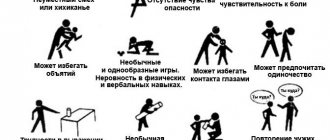Neurosis is the collective name for a group of diseases that are based on temporary (reversible) disorders of the nervous system that arise under the influence of various traumatic factors.
Symptoms of neuroses include somatic disorders, phobias, dysthymia, etc. A diagnosis of “neurosis” can be made only after excluding pathologies similar to this disease.
Today, this disease is very common: in developed countries, about 10-20% of the population suffers from neuroses.
Neuroses are more often observed in women due to high emotional lability.
People with a weakened nervous system are most predisposed to the development of neuroses.
There are 3 main types of neurotic disorders: neurasthenia, hysterical neurosis (conversion disorder) and obsessive-compulsive disorder . Depressive, hypochondriacal, and phobic neurosis are distinguished as independent nosological units.
Causes of mental neurosis
Of course, the diagnosis of “neurosis” is ambiguous, and it is always caused by a combination of reasons. To some extent, we are all neurotic, which prevents us from achieving our goals. So, what are the causes of neurosis?
- Stress . In general, the formation of any mental disorders is influenced by two factors: the intensity of the stress factor and its duration. This is how stress strengthens the psyche, but only in moderation. If they are exceeded, then we are talking about distress, which provokes neuroses and even psychoses.
- Chronic fatigue . It happens when you work for a long time and never rest. Tension accumulates for quite a long time and is unnoticeable. Neurosis appears when tension crosses a certain level. Moreover, some people think that if work brings pleasure, then there will be no illness. Not at all like that. Any monotonous activity tires you, even if you are having fun. Of course not like that, but still. You need to rest so that there are no neuroses, and further work will be even more enjoyable.
- Problems from which a person cannot find a way out for a long time . To prevent difficult situations from leading to illness, you need to perceive them simply as a problem worth solving. And if you don’t decide, then it’s okay. But in general, it is important to believe in yourself and your ability to find a way out of the most difficult situation. Then the disease will not appear.
Usually the differentiation of causes is much greater. But the main thing is too long or severe nervous tension.
Stress is one of the causes of neurosis
Psychotherapeutic treatment
Psychotherapeutic treatment is selected and prescribed individually depending on the factors that caused stress and provoked the onset of neurosis. It is important to eliminate the risk of recurrence of the disease.
Our clinic’s specialists use the following psychotherapy methods:
- Existential
- as the main goal, changing a person’s life by leading him to comprehend his life, discover or revive his internal potential, actualize all necessary resources, and understand his true life needs. - Rational
– studying the patient’s personality, identifying the causes of the problem, helping in the formation of a behavior model aimed at strengthening new personal qualities. - Hypnotherapy.
- Family
– when problems are caused by a difficult family situation and painful relationships with relatives, children, or spouse. - Personality-oriented
- helps the patient get to know himself better, realize his desires, learn to cope with his reactions, suitable for people under more authoritative influence, accustomed to doing everything correctly, as others say, “as it should be.” - Cognitive and behavioral
- a practical approach for people who do not like to “dig” into the mind and involves working with facts, thoughts, actions and their consequences; therapy is based on logic.
How does neurosis manifest itself?
The manifestations of neurosis are very diverse, sometimes it is even difficult to distinguish it from the norm. However, we will list some markers that indicate the presence of such conditions.
- Fast fatiguability . Yes, it can be both a cause and a consequence of neurosis.
- Acute stress response . A person reacts aggressively, tearfully or fearfully even to a minor event. This can be conveyed with this metaphor. Imagine that your normal stress level is 0. A dangerous state for the psyche is above 8. If an event occurs that increases the anxiety level by 3 points, then the person remains generally prosperous, thinks normally and is optimistic about the future. If a person’s usual level of anxiety is 5, then an event of the same intensity can cause a reaction dangerous to mental health - the total score will be exactly 8.
- Decreased mental abilities . The reason is simple - a person constantly focuses on traumatic events, which is why his brain is not able to solve other problems. Unfortunately, psychologists have proven that multitasking is more an ability of computers than of humans. Attention is distributed among some heterogeneous objects. Therefore, it turns out that some part of it is spent on anxiety, and only a small part of it is spent on productive activity.
- Decreased self-confidence . This point is related to the previous one. Increased levels of anxiety are always associated with negative thoughts. They prevent the brain from functioning productively, which reduces self-confidence, which is already spoiled by anxiety. A person spins in his thoughts like a squirrel in a wheel, and with each cycle it gets worse and worse. A decrease in self-confidence is dangerous for the brain because a person does not try to solve complex problems, and after a while he gets used to perceiving even simple ones as difficult. Although psychologists say that we must learn to perceive even the most difficult tasks as easy.
- Psychosomatics . Neurosis leads to diseases such as hypertension, diabetes, cancer, and stomach ulcers. The overall level of immunity decreases, and therefore a person becomes prone to infectious diseases, starting with ARVI and ending with more dangerous diseases. In addition, neuroses manifest themselves in the form of phobias, obsessive thoughts, and panic attacks. The reason for psychosomatics has been scientifically proven - each emotion is expressed in certain organs of the body. If the tension is excessive and it does not go away, then naturally a disease occurs.
Even minor events can cause tearfulness
Types of neurosis
- Neurasthenia . This is a disease characterized by increased fatigue. Neurasthenia is classified into hyposthenic and hypersthenic types. In the first case, the person is apathetic, low-emotional, and has no strength for long-term social contacts. Hypersthenic neurasthenia is characterized by increased irritability.
- Phobias . These are obsessive fears. Phobias differ from ordinary fears in that they occupy the entire brain, and a person cannot switch to something else no matter how much he or she wants to. Phobias can be combined with ritual actions that help get rid of them, and in this case we are talking about obsessive-compulsive disorder, which is neurotic in nature. Examples are frequent hand washing (unproductive. Thus, a person may go wash his hands just to relax).
- Obsessive-compulsive neurosis . Close to the previous one, since both of them deal with obsessive thoughts. It’s just that in the previous example we were talking about fears, but here it’s a little different. So, a person may have an obsessive counting. Obsessive-compulsive disorders can also manifest themselves at this point. According to some classifications, phobias belong to obsessive states.
- Dependencies . This is very interesting. Usually addictions are not used to be classified as neuroses, but we can clearly trace the neurotic nature. Addiction is characterized by an obsessive desire to use a drug that can be temporarily relieved by taking it. Moreover, in a stressful situation, these thoughts intensify. In domestic narcology there is such a thing as compulsive attraction. And compulsions of any kind are manifestations of neurosis. In addition, only neurotic (read: psychologically immature) individuals can be dependent. After all, one of the reasons is the fear of realizing oneself as a subject of life activity with the desire to go back to childhood, even for a few days.
- Hysterical neurosis . It does not occur in everyone, but only in people with hysterical accentuation. Characteristic features of the hysterical format are demonstrativeness, egocentrism, and emotional instability. The audience always looks hysterical. This is a kind of performance that a person subconsciously wants to act out. Therefore, another characteristic of hysterics is theatricality. At these moments a person does not look like himself.
- Transference neurosis . It was described by Sigmund Freud, and it consists in the fact that a person subconsciously transfers his past experiences to the psychoanalyst. That is, he suddenly begins to feel the same emotions for him as for a certain person. An example of transference in a broad sense is an attempt to build a personal relationship with a person who resembles an ex or ex, provided that love for him remains. Or, on the contrary, hatred of people who are similar to their former soulmate.
Hysterical neurosis can occur in people with hysterical accentuation
There are many other types, but these are enough to form a general idea.
Worth seeing: Hysterical neurosis
Forms of the disease
There are two forms of neurasthenic disorder - hypersthenic and hyposthenic, sometimes they are considered as successive stages of the disease.
The development is based on the mechanism of strengthening the processes of excitation of the brain with a weakening of the processes of inhibition. This is the initial stage of pathology, which is manifested by excessive excitability and increased irritability, which constantly accompany a person and manifest themselves in all areas of his activity.
Signs:
- increased excitability: irritability, tension, short temper;
- emotional instability;
- anxiety;
- difficulty concentrating;
- memory impairment;
- problems falling asleep, restless intermittent sleep, waking up early, feeling groggy after sleep;
- decreased ability to work, difficulty making mental or physical effort;
- vegetative and somatic manifestations (tachycardia, increased heart rate, increased sweating, attacks of dizziness, headache).
Characterized by a predominance of inhibition processes over excitation.
Signs:
- weakness, lethargy;
- apathy:
- depressed mood, tearfulness;
- emotional lability;
- increased drowsiness, daytime sleepiness, problems falling asleep, poor sleep quality;
- fixation on ailments, hypochondiac state.
There are three stages in the course of neurasthenia:
- Increased irritability. Quite ordinary things cause strong irritation: conversation, minor noise, awkwardness, minor failures. For trivial reasons, the patient loses self-control and becomes enraged. Has difficulty falling asleep, sleeps poorly, wakes up sleep-deprived, and feels tired throughout the day.
- Increasing symptoms. Even rest does not help the symptoms disappear or at least reduce them. The patient is constantly tired, any work involves significant effort. Attacks of impotence and tearfulness appear.
- A stage of severe nervous disorder characterized by complete disability. The patient is apathetic, lethargic, drowsy, depressed, and shows no interest in what previously occupied him.
Diagnosis of neurosis
A very large number of psychological questionnaires can also determine a person’s neurotic states (anxiety, obsessive thoughts, and so on). But they are all integral (that is, they examine several different mental characteristics), and therefore they take a lot of time to complete. Therefore, a separate express diagnosis of hake and hess neuroses was developed, in which a person needs to answer 40 questions. You can test yourself using this questionnaire, since it can be completed online.
Diagnosing neurosis in children is a much more difficult task, since in them the disease may manifest itself slightly differently. At the same time, the consequences of neurotic manifestations are much worse. One of the manifestations at an early age is regression of mental functions, when the child rolls back in development and loses recently acquired skills. To diagnose an illness in a child, projective techniques are used (for example, a house, a tree, a person, my family, a non-existent animal).
Psychotherapy for neuroses
How does a psychotherapist treat panic attacks and other neurotic manifestations? Cognitive behavioral therapy and meditative techniques are used to treat neuroses. The first allows you to understand your inner world, and the second allows you to reduce the level of anxiety and create a springboard for instilling new beliefs in yourself. Meditations can be completely different, but they all have one thing in common - concentration on one thought or process.
Meditative treatment techniques help achieve good results
Thus, the simplest meditation involves focusing on the sensations associated with breathing. Autotraining is also a meditative technique in which you focus on feelings of warmth and relaxation in the body. Saying affirmations is also a meditation during which you focus on certain thoughts.
All meditation techniques can be combined, and their results are enhanced. Thus, affirmations can be spoken while already in a trance state caused by meditation. Then internal criticism decreases, and it is much easier to accept new attitudes.
As for cognitive behavioral psychotherapy, its essence is as follows. All our behavior is a set of reactions to certain stimuli. Our brain works reflexively, which was proven by Pavlov. Therefore, even our most complex behavior can be reduced to a set of conditioned reflexes and skills that were formed during the learning process.
All stimuli are refracted through the prism of our thinking. If it is negative, neurosis is provoked. Optimists are not neurotic, because they believe that all problems can be solved. Therefore, the essence of cognitive behavioral therapy is the formation of an optimistic outlook on life. Psychotherapy for neuroses is quite easy to understand, but it is worth understanding that a person influences his thinking himself, and a psychotherapist can only help him.
Psychotherapy for panic attacks is the same as for other manifestations of the disease - meditation and cognitive behavioral psychotherapy in neurology.
Drug treatment
The medicinal part of the treatment is aimed at harmonizing the work of neurotransmitters responsible for the transmission of nerve impulses, since their decrease causes deterioration in mood, apathy and irritability, and decreased resistance to stress. The problems are added by a high concentration of cortisol and adrenaline, which cause spasm of blood vessels and muscle tissue, tachycardia, fears, and it can also be normalized with the help of medications. Psychotherapy is aimed at finding the causes of neuroses and helps to cope with stress without harming health, to develop schemes that allow you to relieve stress without taking drugs and learn to exist in society.
Drug treatment of neurosis in adults involves taking the following groups of drugs:
- Antidepressants
- the dosage and duration of the course are selected individually, they are not addictive. According to the mechanism of action, they indirectly or directly participate in blocking the direct and reverse uptake of serotonin, dopamine, norepinephrine, or block the enzyme involved in the destruction of these neurotransmitters. Antidepressants lead to increased levels of neurotransmitters in synapses, which in turn leads to more efficient transmission of nerve impulses. The effect occurs 1-2 weeks after administration, the course should be 2-3 months. - Tranquilizers
- affect the transmission of nerve impulses in the brain, cause inhibition of the nervous system, and have a sedative and anti-anxiety effect. When taking them, it is prohibited to drive vehicles or perform work that requires coordination of movements, since they affect concentration and reaction speed. Most often, benzodiazepine tranquilizers and preparations of other chemical compounds are used for treatment, for example, daytime tranquilizers (which do not cause drowsiness and addiction (Hydroxyzine, tofisopam, etc.). - Neuroleptics
are drugs that, through various mechanisms, are able to harmonize dopamine metabolism in the nervous system. Usually, for neuroses, so-called minor neuroleptics are used. They do not cause sedation or inhibition. The most commonly used are: sulpiride, alimemazine, thioridazine, etc.) - Sedatives of plant origin
- used for mild types of neurosis (after diagnosis by a doctor). They are not addictive and do not have many side effects, but they work approximately on the principle of tranquilizers. Herbal sedatives are often used - motherwort, tincture of peony or valerian root, hawthorn, etc.












